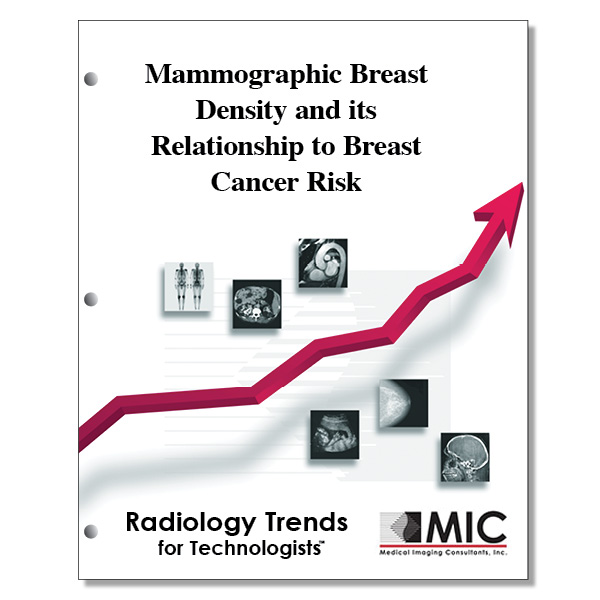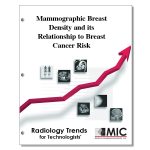

Mammographic Breast Density and its Relationship to Breast Cancer Risk
A presentation of the relationship between dense breasts and the likelihood of developing breast cancer. Imaging methods and techniques are discussed.
Course ID: Q00070 Category: Radiology Trends for Technologists Modality: Mammography3.0 |
Satisfaction Guarantee |
$34.00
- Targeted CE
- Outline
- Objectives
Targeted CE per ARRT’s Discipline, Category, and Subcategory classification for enrollments starting after June 11, 2024:
[Note: Discipline-specific Targeted CE credits may be less than the total Category A credits approved for this course.]
Breast Sonography: 2.25
Patient Care: 2.25
Patient Interactions and Management: 2.25
Mammography: 3.00
Patient Care: 2.50
Patient Interactions and Management: 2.50
Procedures: 0.50
Anatomy, Physiology, and Pathology: 0.50
Magnetic Resonance Imaging: 1.50
Procedures: 1.50
Body: 1.50
Registered Radiologist Assistant: 3.00
Procedures: 3.00
Thoracic Section: 3.00
Sonography: 1.50
Procedures: 1.50
Superficial Structures and Other Sonographic Procedures: 1.50
Radiation Therapy: 2.25
Patient Care: 2.25
Patient and Medical Record Management: 2.25
Outline
- Introduction
- Methods of Measuring Breast Density
- Relationship of Breast Density and Breast Cancer Risk
- Alternative Explanations for the Link Between Breast Density and Cancer Risk
- Relationship Between Nonhormonal Factors and Breast Density and Breast Cancer Risk
- Relationship Between Hormonal Factors and Breast Density and Breast Cancer Risk
- Plausible Factors That May Explain the Association of Breast Density with Breast Cancer Risk
- Future Directions
Objectives
Upon completion of this course, students will:
- understand the relationship between breast density and breast cancer risk
- know the characteristics of the follicular phase of the menstrual cycle
- be familiar with the most common form of breast lumps during premenopause for women between the ages of 40-49
- understand the characteristics of breast density measurement
- know the characteristics of breast tissue in the post-menopause woman
- understand the Wolfe classification of parenchymal patterns
- know the reason for including breast density in the BI-RADS report
- be familiar with the Breast Imaging Reporting and Data System utilized in the United States
- know the methods of quantifying and qualifying breast density
- know how many categories BI-RADS has
- understand which method used an acetate overlay that was placed over the mammogram and traced with a wax pencil
- know which method of assessing breast density shows agreement of 90% or greater
- know the limitations of the current planimetry method of measuring breast density
- be familiar with which imaging modalities are being explored as a possible means of measuring breast density
- know the major problem with the Wolfe classification system
- understand the relationship between breast density and cancer risk based on the twelve studies examined
- be familiar with the author’s conclusion regarding the twelve studies in which quantitative methods were employed
- know what percentage of breast cancer risk is attributable to higher breast density
- know the future trend of the incidence of breast cancers
- know what percentage of breast cancers are attributable to the breast cancer gene
- know the causes of involution of the breast
- understand the factors which may influence breast density
- be familiar with the masking hypothesis
- be familiar with the risk factors for breast cancer
- thoroughly understand the “masking” hypothesis
- understand the clinical significance between past and current density
- understand the relationship between aging and breast density
- understand the relationship between body weight and breast density
- understand the relationship between body weight, breast density and breast cancer risk
- be familiar with the relationship between aging, body weight, parity and breast cancer risk
- know the relationship between other risk factors and breast density
- understand the relationship between nulliparous women and breast cancer risk
- be familiar with the risk factors for breast cancer
- be familiar with the use of hormone replace therapy and how often it alters and slows normal breast involution
- know the clinical significance of HRT regimens
- understand the relationship between HRT and breast density
- understand the effect on breast density when HRT is used cyclically as compared to continuous usage
- know the estrogen receptor modulators
- understand the effects of selective estrogen receptor modulators and other hormonal agents
- be familiar with the role of estrogen and breast cancer risk
- understand the relationship between genetics and breast density
- know why digital mammography may be ideal for density assessment
- know the impact of breast density on the future of risk assessment management
- be familiar with the author’s conclusion regarding risk factors and breast density
